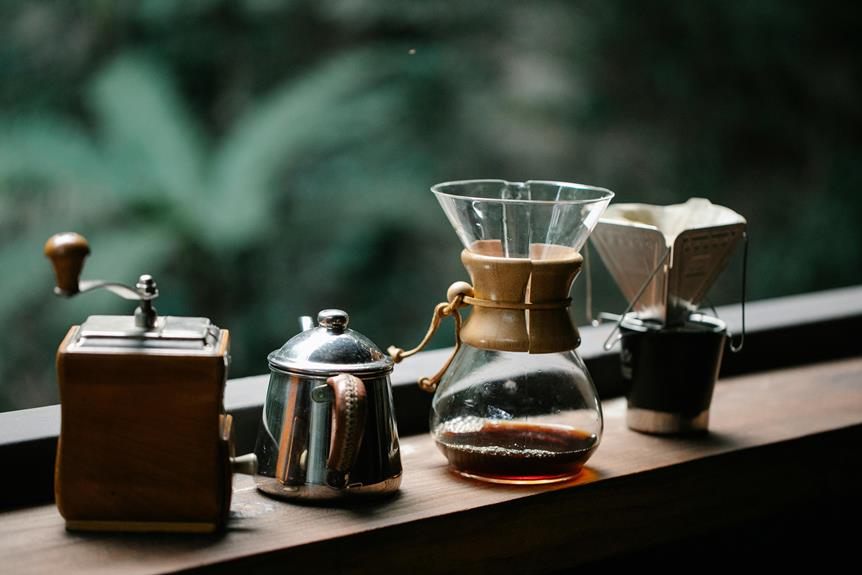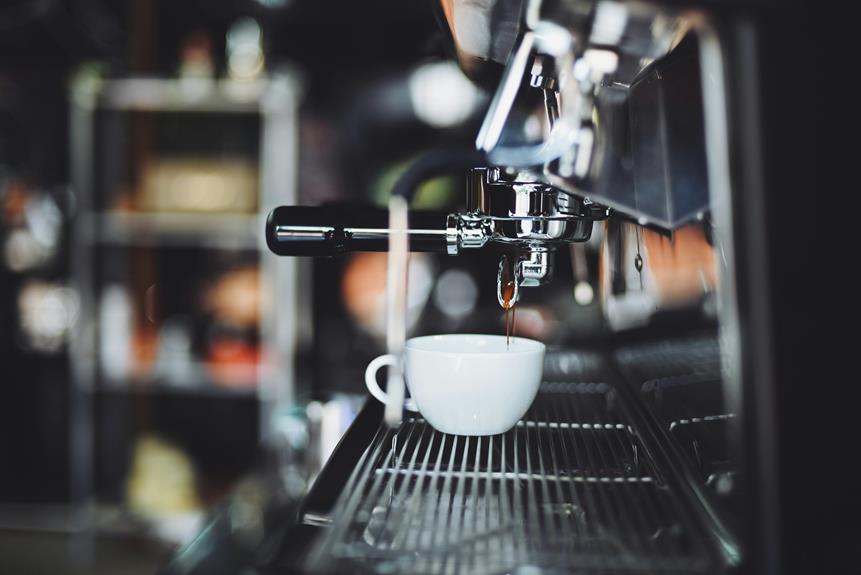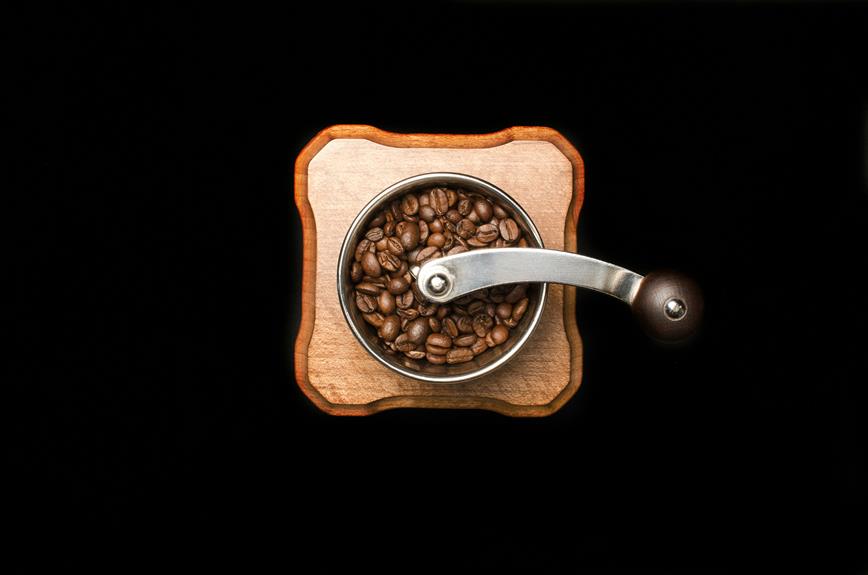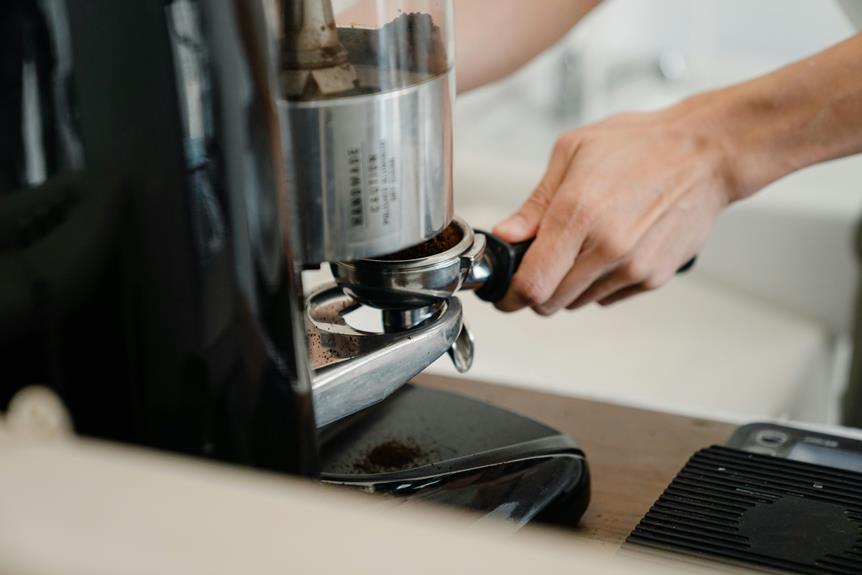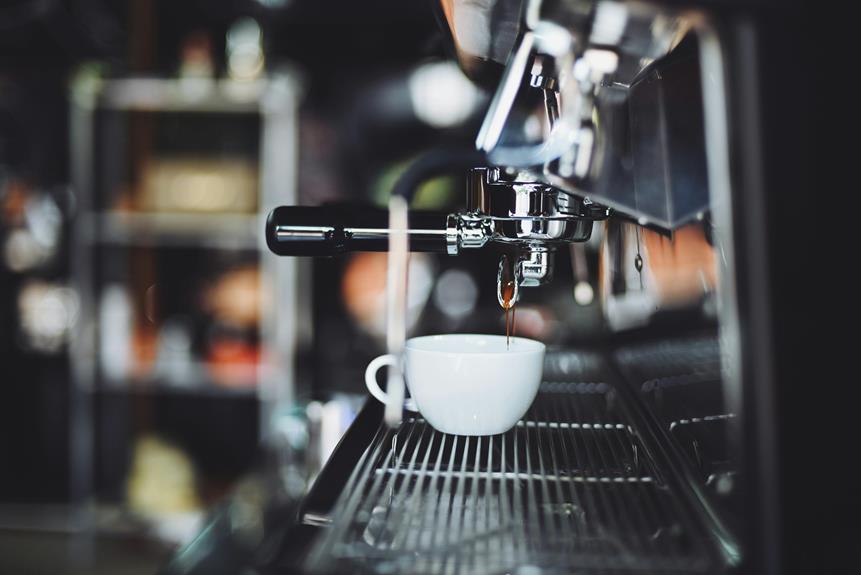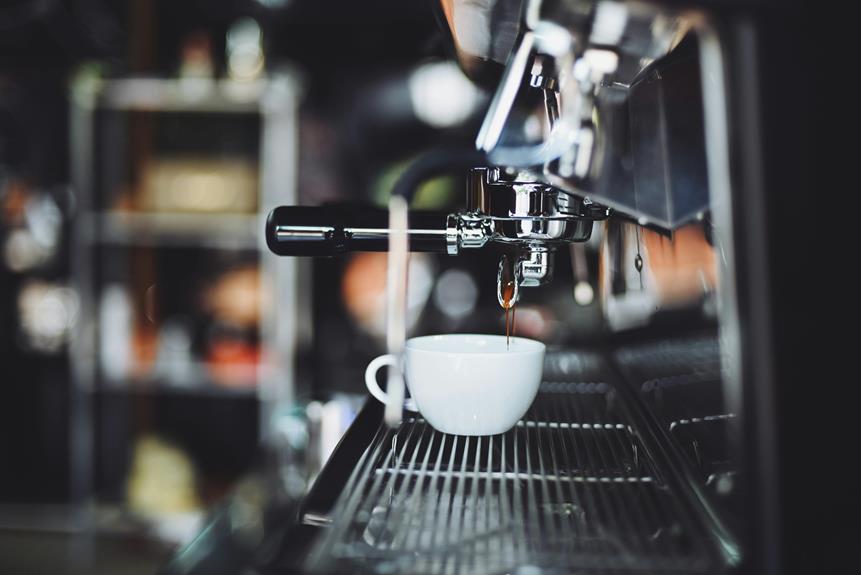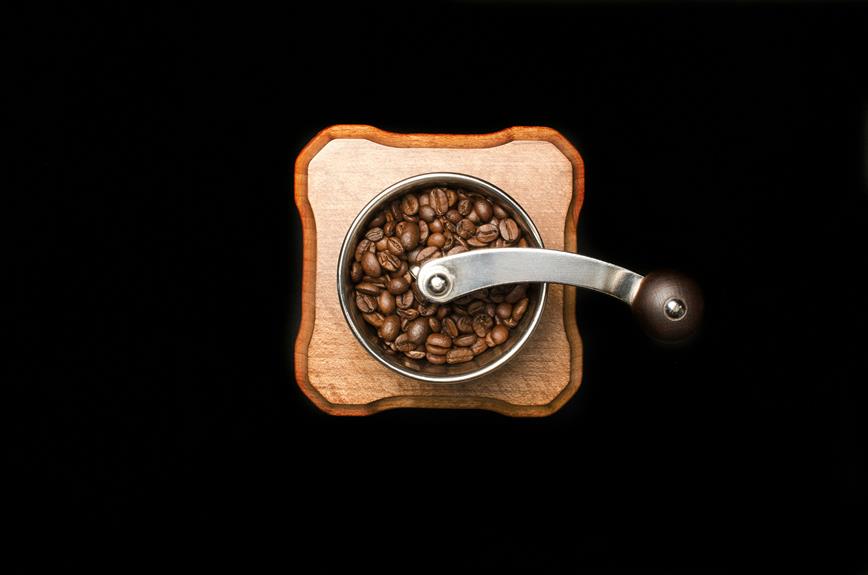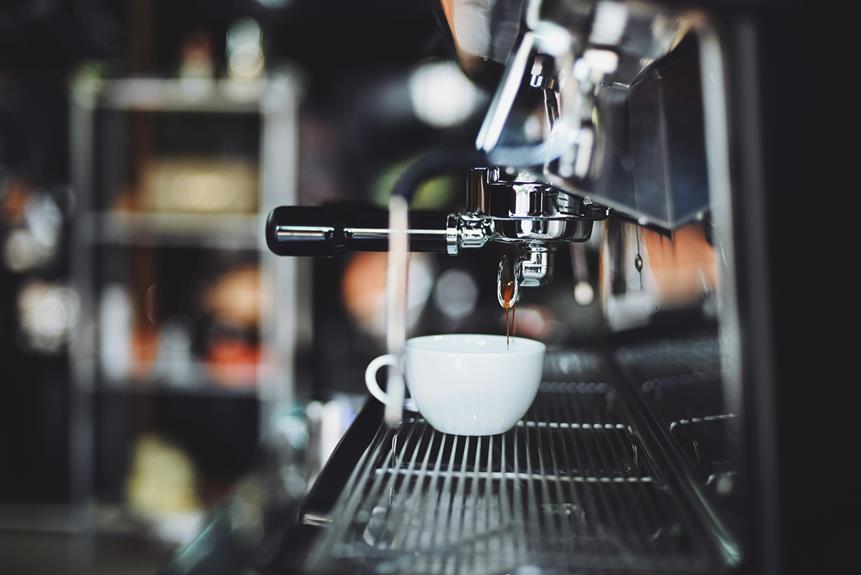You need to adjust your coffee grinder to suit the specific brew method you're using, as the ideal grind size and distribution can make or break the flavor of your coffee. Fine grinds are best for espresso, medium-coarse for drip brewing, and coarse for French press. Experiment with different grind sizes to find the perfect balance for your preferred brew method. Choose the right grinder type, considering brewing method, budget, and personal preferences. Adjust the grinder's settings to achieve the ideal grind distribution, and don't forget to maintain it regularly to preserve high-quality grind quality. Now, let's dive deeper into the specifics.
Key Takeaways
- Adjust grinder to extremely fine (1-2 mm) for espresso machines, medium-coarse for drip brewing, and coarse for French press.
- Experiment with different grind sizes to find the perfect balance for your preferred brew method.
- Burr grinders provide a consistent grind size, but the right size must be chosen for the specific brew method.
- Regular grinder maintenance, including cleaning and descaling, is crucial for optimal grind quality and preventing clogs.
- Check grinder settings for consistency across each batch to ensure perfect particle distribution and adjust as needed.
Understanding Grind Sizes and Ratios
Get familiar with the various grind sizes and ratios, as they play a crucial role in brewing the perfect cup of coffee.
You'll want to understand how to adjust your grinder to achieve the ideal grind distribution, which affects the flavor profiles of your brew. A burr grinder allows for a more consistent grind size, but you still need to know what size to aim for.
A fine grind is best for espresso, while a medium-coarse grind suits drip brewing. French press, on the other hand, requires a coarse grind to prevent over-extraction.
Experimenting with different grind sizes is necessary to find the perfect balance for your preferred brew method. Remember, the grind size will directly impact the flavor profiles of your coffee.
A well-balanced grind will bring out the desirable flavors, while an imbalanced one will result in bitter or under-extracted coffee. By mastering the art of grind size and ratio, you'll be well on your way to brewing exceptional cups of coffee that suit your taste preferences.
Choosing the Right Grinder Type
Selecting the right grinder type is essential, as it directly impacts the quality of your grinds and ultimately, the flavor of your coffee.
You'll want to weigh your brewing method, budget, and personal preferences when choosing a grinder.
Blade grinders are a cost-effective option, but they can generate heat, which can damage your beans. They're also noisy and require frequent cleaning.
Burr grinders, on the other hand, are a popular choice among coffee enthusiasts. They produce a consistent grind and don't generate heat.
You can opt for a flat burr or conical burr grinder, depending on your needs. Flat burr grinders are more affordable and suitable for most brewing methods, while conical burr grinders are ideal for pour-over and Chemex brewing.
When it comes to grinder maintenance, look for a model with easy-to-remove parts and a compact design that reduces dust accumulation.
Noise reduction is also an important factor, especially if you plan to use your grinder during early morning hours. Think about a grinder with a low decibel rating or a silent operation feature.
Grinding for Espresso Machines
When grinding for espresso machines, you'll need to achieve an extremely fine grind, typically in the range of 1-2 mm, to facilitate perfect extraction and flavor.
This is because espresso machines operate at high pressures, requiring a precise grind size to guarantee perfect flavor and crema formation.
If your grind is too coarse, you'll end up with under-extracted shots, while a grind that's too fine can lead to over-extraction and bitterness.
To get the perfect grind, you must think about the type of coffee beans you're using.
Espresso roasts, with their bold and intense flavors, typically require a slightly coarser grind than lighter roasts.
Additionally, the origin of your beans can also impact the grind size.
For instance, beans from African regions tend to be more delicate and may require a finer grind, while beans from South American regions are often more robust and can handle a slightly coarser grind.
Perfecting the Pour-Over Grind
You'll need to switch gears and adjust your grinder to a coarser setting for pour-over brewing, which requires a grind size in the range of 0.5-1.5 mm to allow for the right flow rate and extraction.
This coarser grind will facilitate the water flowing through the coffee at the ideal rate, which is vital for a balanced cup. Aim for a grind that's similar to kosher salt or slightly coarser.
If your grind is too fine, the water will flow too slowly, leading to over-extraction and a bitter taste. On the other hand, if it's too coarse, the water will flow too quickly, resulting in under-extraction and a weak taste.
Once you've adjusted your grinder, pay attention to the bloom time, which should be around 45 seconds. This allows the coffee to release its CO2 and prepares it for the rest of the brewing process.
As you pour the water, observe the water flow and make adjustments as needed to achieve the perfect pour-over brew.
Adjusting for Drip Coffee Makers
Ditch the coarse grind and dial in a medium-fine setting for your drip coffee maker, as it requires a grind size between 0.3-0.7 mm to facilitate perfect extraction.
This setting will guarantee the ideal balance of flavor and body in your brewed coffee. If you're unsure, start with a slightly finer grind and adjust to your taste.
To achieve the perfect cup, you'll want to weigh the coffee strength you prefer.
If you like a stronger brew, use a slightly finer grind to slow down the water flow and allow for more extraction. Conversely, if you prefer a lighter cup, a slightly coarser grind will speed up the water flow and result in a less intense flavor.
French Press Coffee Grind Secrets
For French press coffee, opt for a coarse grind size between 1.4-2.4 mm, which allows the coffee grounds to steep properly and brings out the rich, bold flavors characteristic of this brewing method.
This grind size permits the coffee particles to be large enough to prevent over-extraction, yet small enough to allow for a balanced extraction. You'll want to aim for a grind that's similar to kosher salt or slightly coarser.
As you grind your beans, consider the Coffee Body you're aiming for. French press coffee is known for its thick, velvety texture, so you'll want to adjust your grind accordingly.
A coarser grind will result in a heavier body, while a slightly finer grind will produce a lighter body. Experiment with different grind sizes to find your perfect cup.
Optimizing for Aeropress Brewing
Now that you've mastered the coarse grind for French press, adjust your grinder to a finer setting to tap into the full potential of Aeropress brewing, where a medium-fine grind size between 0.5-1.1 mm is ideal.
This range allows for the perfect balance of flavor and body in your brew. With Aeropress tips in mind, aim for a grind that's slightly finer than kosher salt. This will guarantee a smooth, full-bodied brew with notes of chocolate and fruit.
When brewing with an Aeropress, use a medium-coarse grind to allow for the right amount of water flow. This will result in a brew that's rich and full-bodied, without being over-extracted.
Experiment with different brewing techniques, such as steeping times and water temperatures, to find your perfect cup. Remember, the key to ideal Aeropress brewing is finding the right balance between grind size, water flow, and brewing time.
With practice and patience, you'll be well on your way to brewing like a pro!
Cold Brew Coffee Grind Requirements
As you shift your focus to cold brew coffee, you'll need to adjust your grinder to a coarser setting, targeting a grind size between 1.4-2.5 mm to facilitate the slow-drip process extracting the maximum amount of flavor and oils from your coffee beans.
This coarser grind allows for the perfect balance of flavor and body, as the cold brew nuances are more pronounced with a slower extraction.
When it comes to cold brew, the steep time effects are vital.
A longer steep time can result in a bolder, more full-bodied flavor, while a shorter steep time will produce a smoother, more delicate taste.
To achieve the perfect balance, you'll want to experiment with different steep times to find your ideal flavor profile.
Keep in mind that the coarser grind will also affect the steep time, as it takes longer for the coffee to fully extract.
Moka Pot Grind Size Essentials
The ideal grind size for your Moka pot is a medium-fine grind that allows for perfect water flow and extraction.
Aim for a grind size similar to kosher salt or slightly finer. This will facilitate the water passing through the coffee at the right pace, preventing channeling and under-extraction.
To achieve this grind size, you'll need to adjust your grinder accordingly. Start by setting your grinder to a medium-fine setting, then dial it in further based on your pot preferences.
You may need to make small adjustments depending on the type of coffee beans you're using and your personal taste preferences. Regular Moka maintenance, such as cleaning your grinder and pot, will also help promote a consistent grind and maximum flavor.
Troubleshooting Common Grind Issues
One common issue is inconsistent grind size, which can lead to uneven extraction and a subpar cup. To combat this, check your grinder's settings and make sure they're consistent across each batch. You might need to adjust the grind size or calibration to get the perfect particle distribution.
Another issue is clogged grinders, which can affect grind consistency and overall performance. Regular grinder maintenance is key to preventing clogs and ensuring top-notch grind quality. Clean your grinder regularly, and consider descaling it every few months to remove any built-up residue. This will help maintain a smooth, consistent grind and prevent any blockages.
Lastly, if you're experiencing issues with grind fineness or coarseness, it's likely due to worn or dull grinder blades. Consider replacing them or having them sharpened to achieve the perfect grind. By addressing these common issues and performing regular grinder maintenance, you'll be well on your way to achieving the perfect grind every time.
Frequently Asked Questions
Can I Use a Blade Grinder for All Coffee Brewing Methods?
You can't rely on a blade grinder for all brewing methods; it's a common myth. Blade limitations include generating heat, leading to flavor loss and inconsistent grinds, making it unsuitable for methods that require precise grind control.
How Do I Clean My Coffee Grinder to Prevent Flavor Contamination?
You'll want to clean your grinder regularly to prevent flavor contamination, which can alter flavor profiles. Simply wipe down the grinder with a dry cloth, then run a small amount of rice or coffee cleaning tablets through it for thorough grinder maintenance.
What Is the Ideal Storage Method for Ground Coffee to Preserve Freshness?
"As you savor the perfect cup, remember that freshness is fleeting. You'll want to stash your precious grounds in airtight Coffee Canisters, employing clever Freshness Strategies like cool, dark storage to keep flavors from fading like a sunset."
Can I Grind My Coffee Beans in Advance for the Week?
You're wondering if you can grind coffee beans in advance for the week, but be aware that doing so can lead to bean oxidation, affecting freshness. Try freshness testing to see how long your ground coffee stays flavorful before deciding.
Are There Any Coffee Grinders Suitable for Both Home and Commercial Use?
"Oh, you want a coffee grinder that's a superhero, saving the day at home and crushing it commercially? Look for a Dual Purpose, Industrial Grade grinder that can handle your caffeine-fueled dreams, effortlessly switching between home and commercial use."
Conclusion
You've dialed in your grind, and now you're brewing like a pro!
Remember, finding the perfect grind is like finding the perfect dance partner – it takes practice, patience, and a willingness to adjust to the rhythm.
Just as a slight misstep can throw off the entire performance, a misaligned grind can ruin an otherwise perfect cup.
With these tips, you'll be grinding like a pro in no time, and your taste buds will be doing the happy dance!
